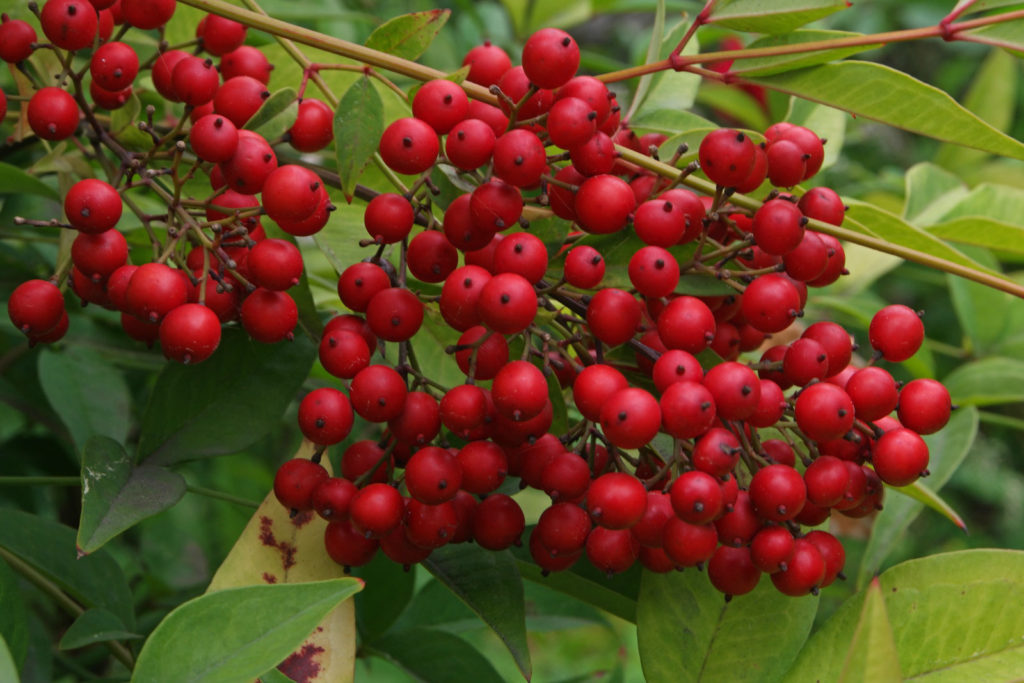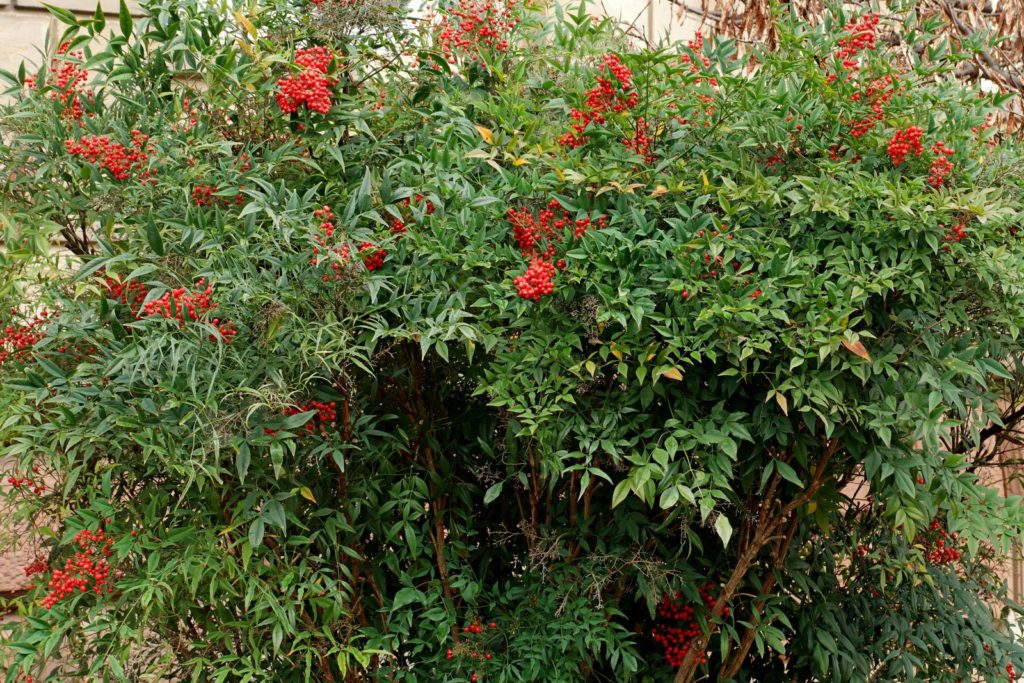By Heather Doolin, Office of Kentucky Nature Preserves
Heavenly bamboo (Nandina domestica), also commonly called sacred bamboo, is an evergreen shrub, vaguely resembling bamboo. Heavenly bamboo began its journey in North America as an ornamental plant, escaping cultivation and invading forests of ten southern states, Kentucky being included in those affected.
Description
One may notice heavenly bamboo throughout many of the plant communities within the southeastern United States, its highest densities reported in upland mixed forests, floodplain forests, and slope woodlands (Stone 2009). Throughout south-central Kentucky, you might notice this plant in a neighbor’s front yard, as a decorative plant in front of many businesses, and in the forested areas surrounding our beautiful limestone slope glades.
Distinct Features
Perhaps the most distinguishing characteristic of heavenly bamboo are its berries. They are a striking red, occurring in clusters (Flora 2009). These berries most closely resemble yaupon holly (Ilex vomitoria), but tend to be a deeper red, nearing purple.

Appearance
Heavenly bamboo is an evergreen shrub displaying multiple, unbranched, slender stems. It grows to approximately seven feet tall and is glabrous (Godfrey 1988). When flowering, you will notice white flowers in terminal clusters, fruiting later into red berries containing one to three seeds each (Miller 2003).
Leaves
The leaves of heavenly bamboo are compound and alternate. They are near the ends of stems and are approximately 20 inches long and 30 inches wide. Their appearance is glabrous and medium green in color. (Godfrey 1988)

Habitat
As mentioned previously, heavenly bamboo in woodlands and forests varying from upland to slope to floodplain (Stone 2009). This plant seems to favor shaded areas under well-established forests with minimum to moderate understory.
Where Found in US
While the state most populated by heavenly bamboo in a 2008 study was Tennessee, several other states throughout the southeastern US are affected by this invasive species, Kentucky being one of them.
How it Got Here
In the early 1800’s, heavenly bamboo was introduced to North America from Asia through cultivation for use as an ornamental plant. Heavenly bamboo escaped cultivation and found its way into healthy woodlands and forests, likely being dispersed by way of birds and mammals.
Ecological Impacts
While heavenly bamboo is not as populous in Kentucky as an invasive species as it is in other southeastern states, it is already displaying many ecological impacts. The berries of heavenly bamboo, while nutritious to some wildlife, can be toxic, along with the leaves of the plant to other animals, particularly ruminants (Burrows 1983). The ability of heavenly bamboo to establish itself quickly and vigorously in native communities puts native species at risk. In south-central Kentucky, one particular habitat that is uniquely at risk are glade communities with glade privet (Forestiera ligustrina).
How to Control
The two most useful methods of control for heavenly bamboo are manual removal and herbicide.
Manual
Hand pulling may be laborious but is effective in smaller heavenly bamboo stems. Once the plant grows larger, it can be difficult to remove by pulling up the entirety of the root system. Removing the root system is of utmost importance as the plant can recolonize if root fragments remain. The best time to remove heavenly bamboo is prior to fruiting, preferably before autumn. Following up and remaining vigilant is important with a manual method of treatment.
Herbicides
Herbicides are a useful method in the removal of heavenly bamboo. A cut stump method, spraying or sponge-application of the stump with a 20% solution of glyphosate, or a brush-control herbicide containing triclopyr can be useful. Application is best in late summer to early autumn, during heavenly bamboo’s dormant season. As with manual removal, be sure to follow up as resprouting can always occur. A final note is that glyphosate is a non-selective herbicide and as such, care should be taken with application in sensitive habitats.
CITATIONS
Stone, Katharine R. 2009. Nandina domestica. In: Fire Effects Information System. U.S. Department of Agriculture, Forest Service, Rocky Mountain Research Station, Fire Sciences Laboratory (Producer). Available: https://www.fs.fed.us/database/feis/plants/shrub/nandom/all.html
Flora of North America Association. 2009. Flora of North America: The flora. Flora of North America Association (Producer). Available: http://www.fna.org/FNA
Godfrey, Robert K. 1988. Trees, shrubs, and woody vines of northern Florida and adjacent Georgia and Alabama. Athens, GA: The University of Georgia Press. 734 p.
Miller, James H. 2003. Nonnative invasive plants of southern forests: A field guide for identification and control. Gen. Tech. Rep. SRS-62. Asheville, NC: U.S. Department of Agriculture, Forest Service, Southern Research Station. 93 p. Available online: http://www.srs.fs.usda.gov/pubs/gtr/gtr_srs062/
Burrows, G. E.; Tyrl, R. J. 1983. Ornamental plants potentially hazardous to cattle. The Bovine Practitioner. 18: 188-194.

Heather Drake is a natural lands manager for the Office of Kentucky Nature Preserves. She is from the mountains of Virginia, for which she credits her love of the outdoors. Heather has a B.S. in Environmental Science from Georgetown College and a M.E.M in Water Resource Management and M.F. in Forest Management from Duke University. Her current work focus is in managing preserves at the habitat level, controlling for invasive species, utilizing prescribed burns, and habitat restoration. Heather enjoys learning about native plants and their medicinal uses, new management strategies, and land use history.
